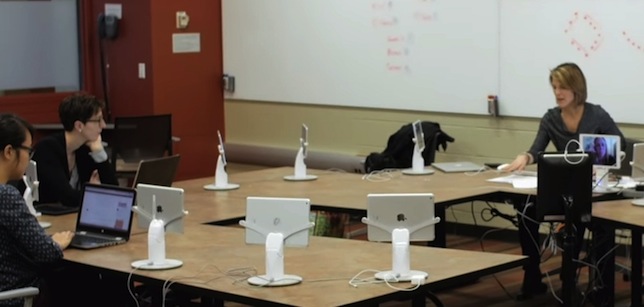Robotics Enter Hybrid Instruction
- By Dian Schaffhauser
- 09/01/15
A doctoral program at Michigan State University has begun experimenting with the use of
robots to pull on-campus and off-campus students closer together in class. The Educational Psychology and Educational Technology (EPET) doctoral program focuses on the study of human learning and
development and diverse technologies supporting learning and teaching. During a spring course in 2015 all but one student participated by being
present in the form of an Apple iPad affixed to a swivel robot that was stationary; one student was on a robot that could move around the
classroom.
As Christine Greenhow, the faculty member who led the seminar course, explained, the experiment was intended to expand beyond traditional
Web presence of online students. "When you are using videoconferencing, it's very common to see all these different faces on the screen if
you're here in the classroom and not really know where to look. It creates this distance between the speaker who's online and the speakers in
the class," she said in a video about the
project. "What if we could put online students in the classroom in a robot? How would their presence change?"

The lone student who always attended in person, Sarah Gretter, noted that many of the students already knew each other, which presented a
"kind of distance" between them and her. But as the course progressed, she said, "and we got to know each other, got to use the technology, we
positioned the robots into a semi-circle and that transition really helped. It looked more like a natural environment for a classroom and it
made me feel more integrated into the class."
Greenhow, an assistant professor of counseling, educational psychology and special education, worked with the design studio within the
College of Education to set up the virtual classroom.
The experiment wasn't hassle free. For one, the students had to learn how to use the robotic technology. Those on the stationary
Kubi iPad stands could turn their head screens to look at somebody speaking, but
they couldn't see the entire room. The mobile robot had to figure where to move around without running into furniture.
But even then, said Greenhow, the initiative offers "learning and educational opportunities" that are "breaking new ground" in blended
learning.
Even though there's more to learn, she said, "the faculty and student response to using the robots in class has been positive... Those of us
on campus, we felt our colleagues were physically present; and for the online students, they felt that they were in this class. We had several
students tweet out, 'Best class ever!' or 'Breaking new ground in educational technology.'"
Greenhow added that a similar class approach will be tried again in the 2016 spring semester. The next step will be to determine the best
ratio of "robot" students to those physically present.
"We're supposed to be about pushing the boundaries in educational technology and here we really are breaking new ground and the students
love that," she said.
About the Author
Dian Schaffhauser is a former senior contributing editor for 1105 Media's education publications THE Journal, Campus Technology and Spaces4Learning.